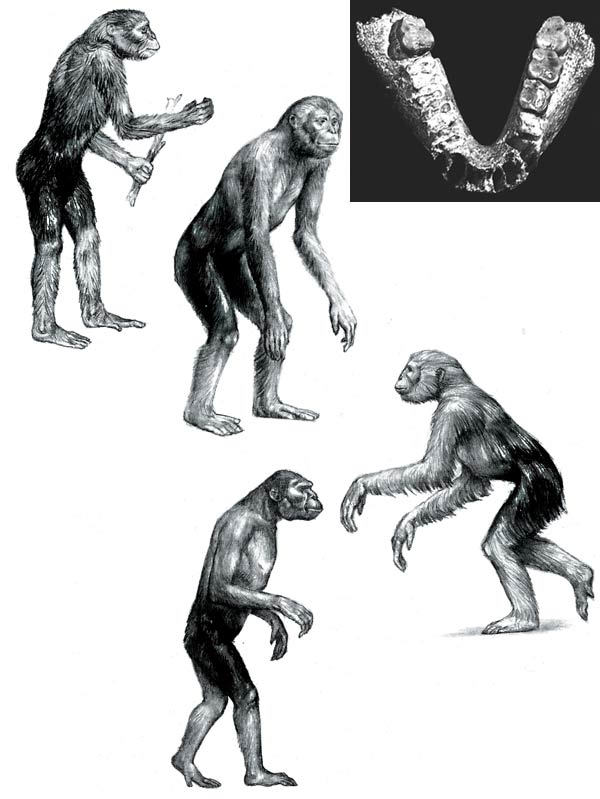Bigotry: The Dark Danger
The Evolution Impasse 2
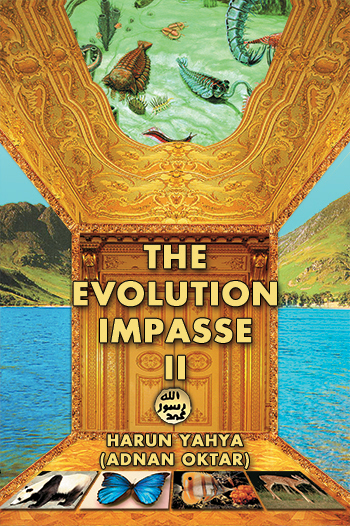
< <
7 / total: 13
R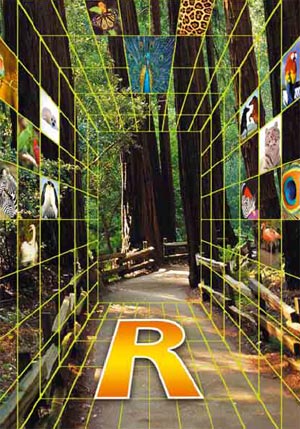 Ramapithecus Error, TheEvolutionists who suggested that the Ramapithecus fossils discovered in India go back some 15 million years also proposed that these fossils were a definite intermediate form in the scenario of human evolution. However, it was realized that these fossils actually belonged to an extinct species of ape, and Ramapithecus was quietly removed from the imaginary human family tree.198 The first Ramapithecus fossil discovered consisted of an old jaw made up of two parts. Yet on the basis of these parts, evolutionist artists somehow managed to draw pictures of Ramapithecus in his natural habitat, together with his family. EVOLUTIONISTS' SOURCE OF INSPIRATION WAS A SINGLE JAWBONE!
The first Ramapithecus fossil discovered consisted of a partial jaw, broken into two pieces. Evolutionist artists, however, had no difficulty in portraying Ramapithecus and even his family and habitat, based solely on these jaw fragments. Recapitulation Theory— See Ontogeny Recapitulates Phylogeny Theory, The. RecombinationRecombination means a new genotype (or hereditary structure) being produced by the genetic characters of the two genders combining. However, recombinations must not be confused with mutations. In mutation, in order for changes taking place in the individual’s genotype to be effective, they must take place in the reproduction genes. Recombination, on the other hand, is a constant process that gives rise to new combinations of genes in every offspring, as a result of natural sexual reproduction. Recombination results from the regrouping of genes from the mother and father during the formation of their reproductive cells. Before cell division, the fertilized egg always takes half its genetic material from the mother and half from the father, but recombination plays a definitive and influential role in the formation of variety. (See Variation.) Thus except in the case of identical twins, two offspring are never identical to one another, and neither are their genetic contents exactly the same as their parents’. Some evolutionists interpret variation through recombination as an evolutionary factor. 199 However, this is not scientifically valid. Variation is a natural process arising from genetic mixing during reproduction. Yet there is no question of a new species emerging through recombination, or of new information being added beyond that already recorded in the genes. Studies on recombination occupy a very important place in the understanding of genetic mechanisms. Recombination has guided scientists’ production of the chromosome map, identification of genetic abnormalities, and in genetic transplants of one chromosome to another. Reconstruction (Imaginary Pictures)Using various propaganda techniques, evolutionists seek to camouflage their lack of any evidence to support their theories. The most important of these techniques is reconstruction, which involves an “artist’s conception” of what a living thing might have looked like, based on a piece of bone that has been unearthed. All the ape-men one sees in newspaper and magazine illustrations are reconstructions. 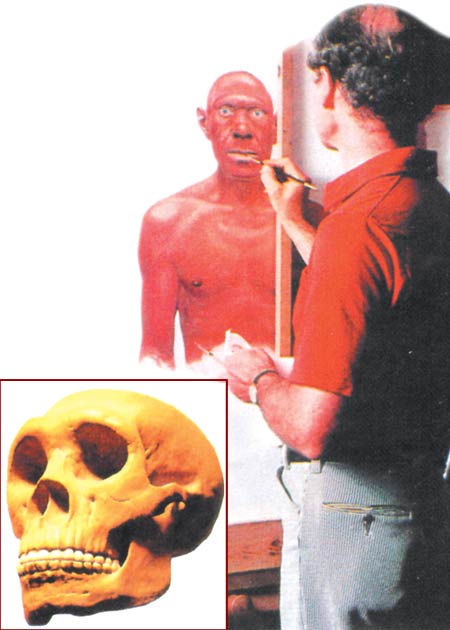
This picture, based on a skull bone, is a good example of the imaginative way in which evolutionists interpret fossils. However, since the fossil records regarding the origin of man are generally scattered and deficient, any estimations based on them depend largely on imagination. Accordingly, reconstructions of the fossils are designed totally in line with the requirements of the ideology of evolution. The Harvard University anthropologist David Pilbeam emphasizes this: “At least in paleoanthropology, data are still so sparse that theory heavily influences interpretations. Theories have, in the past, clearly reflected our current ideologies instead of the actual data.”200 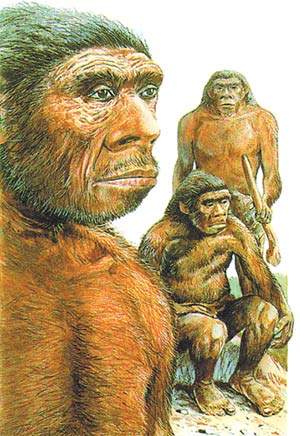  Reconstructions reflect only the imagination of evolutionists, not the scientific facts. Only the very general features of a creature can be produced based on bone remains alone. The really distinguishing features are the soft tissues, which soon disappear over the course of fossilization. It is easy for an evolutionist to come up with an imaginary being by shaping those soft tissues however he sees fit. As Earnst A. Hooten says: To attempt to restore the soft parts is an even more hazardous undertaking. The lips, the eyes, the ears, and the nasal tip leave no clues on the underlying bony parts. You can with equal facility model on a Neanderthaloid skull the features of a chimpanzee or the lineaments of a philosopher. These alleged restorations of ancient types of man have very little if any scientific value and are likely only to mislead the public… So put not your trust in reconstructions. 201 The biased interpretation of fossils and the production of fantastic drawings are evidence of how intensively evolutionists resort to deception. Yet compared with the various concrete frauds that have been perpetrated over the past 150 years, these pale into insignificance. No concrete fossil evidence supports the picture of the ape-man constantly propagated in the media and in academic sources. Evolutionists may draw and paint imaginary beings, but the lack of any fossils belonging to those creatures is a major stumbling block for them. One of the methods often used to resolve this problem has been to manufacture whatever fossils they have been unable to find. Piltdown Man, a major scandal in the history of science, is one instance. (See Piltdown Man Fraud, The.) ReductionismReductionism is the idea that things that do not appear material can be explained in terms of material effects. The materialist philosophy underlying the theory of evolution assumes that everything that exists consists solely of matter. (See Materialism.) According to this philosophy, matter has existed for all time, and nothing exists apart from matter. Materialists employ a logic known as reductionism to support these claims. For example, the human mind cannot be touched or seen. In addition, the mind is not centered anywhere in the human brain. This inevitably leads us to conclude that the mind is a super-material concept. In other words, the entity you refer to as “me,” which thinks, loves, feels anger and sadness, and that experiences pleasure or pain, is not a material entity in the same way as a table or a stone is. But materialists say that the mind can be reduced to matter. According to their claim, the way we think, love, feel sadness and all our other mental activities actually consist of chemical reactions taking place among the neurons in our brains. Our love for another person is a chemical reaction produced by certain cells in the brain, and our feeling fear in the face of an appropriate event is still another chemical reaction. The well-known materialist philosopher Karl Vogt described this logic in the famous words, “Just as liver secretes gall, so do our brains secrete thought.” 202 Gall is a material fluid, of course, but there is no evidence to suggest that thought is also just matter. Regulatory GeneIt is evident that mutations give rise to no evolutionary development, which places both neo-Darwinism and the punctuated model of evolution in a very severe predicament. (See Mutation and The Punctuated Model of Evolution.) Since mutations have a destructive effect, then the macro-mutations referred to by the proponents of punctuated evolution would lead to major damage in living things. Some evolutionists place their hopes in mutations occurring in regulatory genes. However, the destructive character that applies to other mutations also applies to these. The problem is that any mutation is a random change, and any random change in such a structure as complex as DNA gives rise to damaging consequences. The geneticist Lane Lester and the population geneticist Raymond Bohlin describe the mutation predicament: However though macro-mutations of many varieties produce drastic changes, the vast majority will be incapable of survival, let alone show the marks of increasing complexity. If structural gene mutations are inadequate because of their inability to produce significant enough changes, then regulatory and developmental mutations appear even less useful because of the greater likelihood of nonadaptive or even destructive consequences. 203 Experiments and observations show that mutations develop no new genetic information, but only damage the mutated individual, and that it is clearly inconsistent for the proponents of punctuated evolution to expect any such great successes from mutations. RibosomeProteins are produced as the result of highly detailed processes inside the cell, with the assistance of many enzymes, in an organelle called the ribosome. The ribosome itself consists of proteins. This therefore brings with it an unrealistic hypothesis that the ribosome came into being by chance. Even Jacques Monod, a Nobel prize-winner and well-known advocate of the theory of evolution, describes how protein synthesis cannot be reduced solely to information in nucleic acids: The code [in DNA or RNA] is meaningless unless translated. The modern cell’s translating machinery consists of at least 50 macromolecular components, which are themselves coded in DNA: the code cannot be translated otherwise than by products of translation themselves… When and how did this circle become closed? It is exceedingly difficult to imagine. 204 The genetic system requires the enzymes to read this code from the DNA, the mRNA to be manufactured through the reading of these codes, the ribosome to which the mRNA with the code will go and bind to for production, a transporter RNA that carries the amino acids to be used in production to the ribosome, and the exceedingly complex enzymes that ensure the countless other intermediate processes in the same environment. Bear in mind that such a controlled environment needs to be completely isolated and also to contain all the requisite energy sources and raw materials, and the invalidity of the claims of chance can be seen only too clearly. Right-Handed (Dextro) Amino Acids—See Left-Handed Amino Acids RNA World Scenario, TheAsked how the first cell came into being, evolutionists since the early 20th century have offered various theories. The Russian biologist Alexander Oparin proposed the first evolutionist thesis on this subject, suggesting that proteins formed first with a number of random chemical reactions on the primeval Earth, and that these then combined together to give rise to the cell. In the 1970s, it was realized that even Oparin’s most basic assumptions, which he made in the 1930s were false: In the primitive world atmosphere scenario, he had included the gasses methane and ammonia that would permit the emergence of organic molecules. Yet it was realized that the atmosphere at the time was not rich in methane and ammonia, but contained high levels of oxygen that would break down organic molecules. (See The Primitive Earth.) 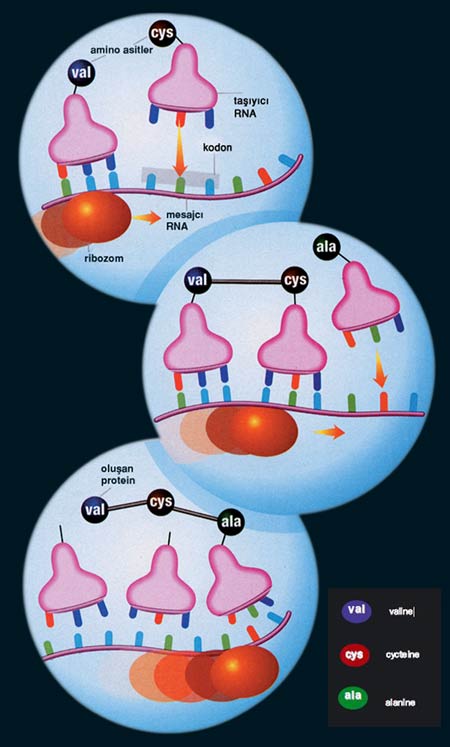
The ribosome "reads" the messenger RNA and sets the amino acids out in accordance with the information it contains. The diagrams show val, cyc and ala amino acids set out by the ribosome and transporter RNA. All proteins in nature are produced in this sensitive manner. No protein has come into being by chance. This dealt a serious blow to the theory of molecular evolution. It meant that all the “primitive atmosphere” experiments, carried by evolutionists such as Miller, Fox and Ponnamperuma, were invalid. For that reason, other evolutionist quests were launched in the 1980s, and the RNA World scenario was put forward. This suggested that rather than proteins, the RNA molecule containing protein information emerged first. According to this scenario—proposed in 1986 by the Harvard chemist Walter Gilbert—billions of years ago, an RNA molecule somehow capable of copying itself came into existence by chance. Later, under the influence of environmental conditions, this RNA molecule suddenly began producing proteins. Later, when the need was felt to hide their information in a second molecule, the DNA molecule somehow emerged. Instead of accounting for the beginning of life, this scenario—every stage of which is distinctly impossible and which is difficult to even imagine—made the problem even worse. It raised a number of insoluble questions: 1. Not even one of the nucleotides that comprise RNA can be accounted for in terms of chance. Then how did nucleotides come together in the appropriate sequence to give rise to DNA? The evolutionist biologist John Horgan admits the impossibility of RNA forming by chance: As researchers continue to examine the RNA-World concept closely, more problems emerge. How did RNA initially arise? RNA and its components are difficult to synthesize in a laboratory under the best of conditions, much less under really plausible ones. 205 2. Even if we assume that RNA, consisting solely of a chain of nucleotides, did come into being by chance, how did it decide to copy itself? By what mechanism did it succeed in doing so? Where did it find the nucleotides it would use while copying itself? The evolutionist biologists Gerald Joyce and Leslie Orgel state the hopelessness of the situation: Our discussion has focused on a straw man: the myth of a small RNA molecule that arises de novo and can replicate efficiently and with high fidelity under plausible prebiotic conditions. Not only is such a notion unrealistic in light of our current understanding of prebiotic chemistry, but it should strain the credulity of even an optimist’s view of RNA’s catalytic potential. 206 3. Even assuming that an RNA capable of copying itself did appear in the primeval world, and infinite amounts of all varieties of amino acids that the RNA needed were available in the environment—if all these impossibilities were somehow overcome, this is still not enough to form a single protein molecule. Because RNA is solely information about protein structure. Amino acids, on the other hand, are raw materials. Yet there is no mechanism here to produce protein. Viewing the existence of RNA as sufficient for protein production is as nonsensical as throwing the thousands of components of a car onto a blueprint and expecting a car to assemble itself. This production cannot take place in the absence of a factory and workers. Dr. Leslie Orgel, a well-known evolutionist biochemist and also known as one of the founding fathers of the 'RNA world' hypothesis, uses the term scenario for the chances of life beginning with RNA. Orgel sets out the features this RNA would need to possess, and the impossibility thereof, in an article titled “The Origin of Life on Earth,” in the October 1994 edition of American Scientist: This scenario could have occurred, we noted, if prebiotic RNA had two properties not evident today: A capacity to replicate without the help of proteins and an ability to catalyze every step of protein synthesis. 207 As you can plainly see, only evolutionist imagination and prejudice could expect these two complex processes, which Orgel describes as indispensable, from a molecule like RNA. Scientific facts reveal that the RNA World thesis, a new version of the claim that life was born by chance, could never come true.
NOTES
198.Roger Lewin, Bones of Contention, Chicago & London: The University of Chicago Press, 2nd edition, 1997, p. 86.
199.Prof. Dr. Yalçın Şahin, Genel Biyoloji, Bilim Teknik Yayınevi, Eskişehir, 1995, p .349.
200.David R. Pilbeam, “Rearranging Our Family Tree,” Human Nature, June 1978, p. 45.
201. Earnest A. Hooton, Up From The Ape, New York: McMillan, 1931, p. 332.
202.Encylopedia Britannica, “Modern Materialism”
203.Lane Lester, Raymond Bohlin, The Natural Limits to Biological Change, Dallas: Probe Books, 1989, 9.141.
204.Monod, Jaques, Chance and Necessity: An Essay on the Natural Philosophy of Modern Biology, 1971, London Penguin:1997, reprint, p. 143.
205.John Horgan, “In the Beginning,” Scientific American, Vol. 264, February 1991, p. 119.
206.Gerald F. Joyce and Leslie E. Orgel, “Prospects for Understanding the Origin of the RNA World,” in The RNA World, edited by Raymond F. Gesteland, Thomas R. Cech, John F. Atkins, 2nd ed., Cold Spring Harbor, New York: Laboratory Press, 2000, p. 62.
207.Leslie E. Orgel, “The Origin of Life on the Earth,” Scientific American, October 1994, Vol. 271, p. 78. |
7 / total 13
You can read Harun Yahya's book The Evolution Impasse 2 online, share it on social networks such as Facebook and Twitter, download it to your computer, use it in your homework and theses, and publish, copy or reproduce it on your own web sites or blogs without paying any copyright fee, so long as you acknowledge this site as the reference.
